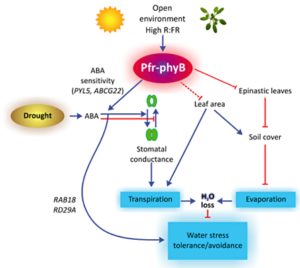Role of phytochrome in mitigating drought stress helps to understands the mechanism happen in Plants. Drought stress is a major constraint of crop production and become more disturbing factor due to rapid changes in climate changes.

Drought
To help against drought conditions plants naturally shows resistance mechanisms, like modifications in morphological, physiological, and molecular characteristics. The drought stress causes many harmful effects in plants by the disruption of various activities. Such as turgor pressure, carbon assimilation, increased oxidative damage and exchange of leaf gases. Similarly, ion balance, enzymatic activity, stem extension, leaf size and root proliferation. And also affected by drought stress and ultimately reduces the yield.
Phytochromes
Phytochromes are a group of photoreceptors in plants, bacteria, and fungi used to detect light. They are sensitive to light in the red and far-red region of the visible spectrum and can be classified as type I, which are activated by far red light, or type II which are activated by red light. Plant Phytochromes control many phases of plant development. Regulation of seed germination (photoblastic), chlorophyll synthesis, seedlings elongation, the size, shape of leaves and the flowering time in adult plants.
Most important sensors in plants are phytochromes, belonging to a family of photoreceptors. Phytochromes have two photo-interconvertible forms, 1) the phytochrome-red and 2) the phytochrome-far red. The Pr absorbs red light in a wavelength 667 nm and later is converted into Pfr. These Phytochrome helps the plants to grow under difficult conditions.
Phytochrome B (phyB) significantly helps the seeds to germinate under low- temperature. Phytochrome D also have very important role in the germination of seeds when exposed and stressed in high temperatures during imbibition.
Among the plant species phyB mediates developmental responses from the seed germination to flowering. Moreover, phyB also regulate abiotic stress responses such as salinity, drought, low and high temperature, high light, and heavy metals. Plants resistance to environmental stresses could be due to the signaling pathways mediated by phyB.
Photoreceptors phyB reduces leaf transpiration, improve protective pigments, increase the antioxidant system, and increase the genes expression related to plant stresses.
PhyA
Phytochrome A persuade flowering, regulates seed germination, seedling photomorphogenesis, suppresses of hypocotyl growth, accumulation of anthocyanins and inhibit strong canopy shade. PhyA and phyB both are present in monocots and dicots. These are considered major clades on the duplication of gene results during early evolution of seed plants.
PhyB
In drought stress tolerance, phyB plays an important role and in the avoidance of water- loss by the stomatal closure. It is observed that phytochromes also part of the stress signaling response, specifically in response to drought stress. That is the major abiotic factor resulting the lower crop productivity worldwide. PhyB1 showed a major role in the auxin and light responses (phototropism and gravitropism) in tomato. While phyB2 enhanced photosynthesis and behaved antagonistically to phyB.
Recent studies show that phyB was part of other signaling pathways in the response of drought stress, such as antioxidant system. In rice ascorbate peroxidase and catalases were upregulated in drought stress conditions as compared to water stress. This upregulation had a positive effect on the phyB mutant plants, which attained a drought tolerance phenotype.
Working Model
Role of phytochrome in drought stress. PhyB induces many morphological and physiological responses during acclimation to open environments (high R:FR), which affect carbon gain at the expense of higher water loss. The PhyB increases sensitivity, enabling rapid identification and response to drought conditions; phyB will gradually alter the location of the leaf area and leaf, alter the soil cover, and thus minimize soil evaporation. On the other hand, phyB also enhances ABA sensitivity by enhancing the expression of certain early ABA signaling components, leading to feed-forward stomatal closure after identification of soil water depletion. As a result, this phyB-controlled mechanism helps plants to finely change the closure of the stomata in order to withstand or prevent water stress in open environments.

Authors: Hafiz Amir Tauqeer, Umair Shoukat Department of Agronomy, University of Agriculture, Faisalabad